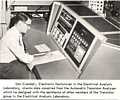|
An unkind or irreverent person might equate engineering work to small boys playing with
"Tinker Toys", occasionally searching the Tinker Toy (or Erector Set) box for a piece with
useful characteristics to complete the object. Maybe going so far as to saw or whittle and/or glue a piece to do the job.
This view may seem harsh - but the fact remains that engineers need/use a great deal of existing
technology to "create".
- Given firecracker powder, with out metal, a gun or cannon is impractical.
- Until the "modern" amplifying vacuum tube (created in part to fill a void ;-))
and/or semi-conductor was developed, radio and TV as we know it are
"almost" impossible. (I'm sneaking that "almost" in there as some folks
say "never say never". ;-))
One can write whole books about "enabling technologies" and "disruptive technologies", which engineers may select and/or enhance to accomplish their task.
This page looks for/at the "enabling technologies" (useful tinker-toy parts) related
to the development of a cost effective IBM 1401 system. The cost of transistors and also core memory
was falling enough to permit creation of a rather general purpose computer system to replace a generation of specialized
punched card machines.
An overly brief difference between a physical scientist and an engineer (both being somewhat technical):
A scientist is more focused on concept, make one work once, get data, cost and reliability not that vital.
An engineer is more focused on cost, manufacterablilty, reliability, maintainability, human interface.
Please don't throw rocks at me, I mean well -
People
Scientists can hit it big - a valuable Nobel prize, but most are low profile.
Engineers can hit it big - Edison, Noyce, but most are hidden by their employers.
Quite a number of "enabling technologies", some "disruptive", were used in the IBM 1401 system ranging
from a long standing IBM expertise with reading and punching punched cards
utilized and enhanced in to 1402 Card Reader Punch - through transistors,
circuit sets, SMS cards, electronic packaging, core memory, ... into the 1401 processor.
|




